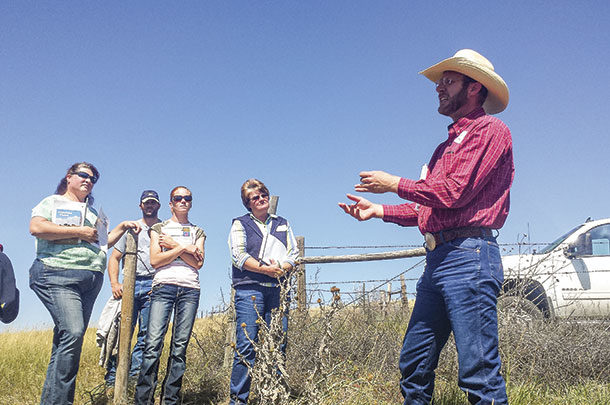A study from the University of Nebraska – Lincoln has found supplementing grazing with low-quality forages is a good way to stretch summer pasture.
Aaron Berger, extension educator with the university, says finding a solution to summer pasture shortage was the primary aim of the study. “Often, there are scenarios where there is more winter feed available than there is summer pasture, and that’s created a scenario where there’s a tremendous demand for summer grass, and the grass is actually the limiting factor in that equation,” he says. “It’s actually the most expensive part of the year.”
Berger says the idea was to put twice as many cows on the same amount of pasture for the same length of time and provide a supplement to replace the grass being grazed in order to run more cows on the same land base.
The researchers double-stocked a smooth brome pasture and supplemented with a mixture of modified distillers grains and ground cornstalks. “We can replace the grass,” Berger says. “It’s not quite a one-to-one relationship, but it’s close.”
Todd Schmieding, a rancher in Seward County, Nebraska, owns a herd of roughly 120 commercial cattle and, like many cattlemen in the Midwest, usually runs out of pasture before he runs out of summer.
He had originally planned to drylot his herd for most of the summer but decided to try supplemental feeding at Berger’s suggestion and modified it to fit the needs of his operation. He grazed his herd on a smooth brome/reed canarygrass pasture of roughly 80 acres during the day and shut the herd in an adjacent drylot overnight, where he fed them a low-quality forage mixture.
Schmieding says after a short period of adjustment, the cattle reacted well to the new system. He says they grazed more heavily on the pasture at first but, as the levels in the pasture decreased, the amounts of supplemental forage and grazed feed they consumed balanced out.
Schmieding says the low consumption of the supplemental feed could have been due to the dry distillers grains in the ration, which would have been less palatable than the smooth brome. By the time pasture forage dropped off, Schmieding had transitioned to rye silage, rendering the mixture more palatable.
Palatability is a fundamental part of making a supplemental feed program work. “Cows have to find the supplemental feed provided to be more palatable,” Berger says. “If they’re refusing to eat the feed, then you’re in a scenario where you’re harvesting more grass than you want to. It has to be something they would willingly consume before they eat the grass.”
Berger says another important point to the program is: With the low-quality forage, the rate of passage is very slow, so the cows are full and not aggressively eating out in the pasture. When the cattle were turned out during the day, they didn’t wear down the pasture so quickly, allowing the pasture to recover quicker and last longer.
Longer-lasting pasture wasn’t the only improvement Schmieding was hoping for. “We did it for animal health as well,” he says. “At that time, we had gotten a bunch of rain, and the cows were in a drylot, and we were having some scour issues develop. It seemed to take the pressure off of that.”
Schmieding says he will most likely keep using this system in the summer. “For what pasture rent is, I think I can drylot a cow for less than that, so being able to utilize my pasture for the longer period of time to potentially lower my animal concentration worked, and it stayed economical that way,” he says. “I think it may look a little different on another year, but we will continue to feed on grass.”
Berger says supplemental feeding is a good program from an economic standpoint. “There was a slight numeric improvement in animal performance using this,” he says. “I think if we can double the number of cattle we have on the same land base, essentially having the same amount of equipment and labor, we reduce our overhead costs per cow per unit.”
Geography and availability of inexpensive low-quality forages is another factor that makes this system usable. The abundant supply of crop residue like cornstalks and ethanol co-products in the Midwest makes supplementation inexpensive and effective. “The strength of this study is showing how their greatest available resource – crop residue – can be utilized to a greater extent,” Berger says.
The cost-effectiveness of the supplemental feed system is going to depend on what is happening within the marketplace. According to Berger, in Nebraska it is cheaper to pay for drylots and extra feed than it is for summer pasture. If that ever changes, the need to use supplemental forage and crop residue will dissipate.
Berger says this kind of supplemental feeding system is meant only for introduced grass pastures because tame grasses respond differently to intensive management than native grasses do.
Native grass stands would not be able to recover or withstand the high amount of consistent grazing a pasture would undergo in this situation. Also, native grasses tend to respond poorly to high levels of available fertilizer. “What’s going in the cow is also coming out the back of the cow,” he says.
“So if we’re putting a fair amount of protein in front of that cow, it’s coming out the back end, and if we’re on native grass, the availability of free nutrients increases weedy species, and natives tend to struggle more to compete with that.”
Berger says smooth brome, meadow brome, orchardgrass, fescue or other grasses that have been bred for a more monoculture-type production and can stand high levels of inputs make the best pastures for accompanying a supplemental feeding program. ![]()
PHOTO: Aaron Berger leads a discussion during a field day near Kimball, Nebraska. Photo provided by Aaron Berger.

-
Carrie Veselka
- Associate Editor
- Progressive Forage
- Email Carrie Veselka











